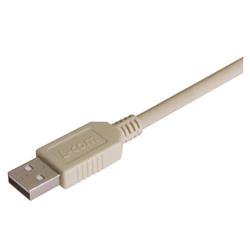
USB (Universal Serial Bus) has become the quintessential interface for a multitude of devices ranging from storage devices to cameras, phones, and even household appliances. Throughout its evolution, USB has adopted various shapes, sizes, and capabilities. Among these various incarnations, some people wonder what is USB-A? USB Type-A stands as the classic, widely recognized connector. Here we will cover the history of USB-A and its distinguishing features.
The History of USB Type A
Universal Serial Bus Type A is the original design for the USB standard and has been around since USB was introduced in the 1990s. A joint effort by several tech giants like Intel, Microsoft, and IBM, among others, the goal was to devise a single connector type that could replace the myriad of connectors then in use, including serial and parallel ports.
USB-A wasn't just about a new shape or design but was a revolutionary idea to have a standard way to connect a multitude of peripherals to computers. When it was launched, the type-A connector set the foundation for what would become a global standard.
Physical Attributes
The USB-A connector is flat and rectangular in shape, making it easily distinguishable from the other types of USB connectors. This design ensures that the plug is inserted in the correct orientation, as it will not fit when reversed. While this feature has made the Type A USB straightforward to use, it also predates the era where reversibility, like that in USB-C connectors, is valued for ease of use.
On the inside, USB-A connectors have four pins – two for power and two for data transfer. In its initial design, it was equipped to handle both power delivery and data transfer, albeit at the speeds and power levels of that era.
Evolution of USB-A: Speed and Compatibility
While the shape of the A-Type USB connector has remained consistent, its capabilities have seen upgrades:
USB 1.0 and 1.1: These were the initial versions, with 1.1 being the most common. They offered speeds up to 12 Mbps (Megabits per second).
USB 2.0: Released in 2000, it was a significant improvement, boasting speeds up to 480 Mbps and becoming a standard for many devices.
USB 3.0 and USB 3.1: Introduced in 2008 and 2013 respectively, these versions are sometimes referred to as "SuperSpeed USB." They drastically improved data transfer rates, with USB 3.0 offering speeds up to 5 Gbps and 3.1 doubling that to 10 Gbps.
USB 3.2: A further evolution, it doubled the speeds of its predecessor to 20 Gbps.
USB 4.0 is the latest version of the Universal Serial Bus (USB) standard. It was released in 2019 and is based on the Thunderbolt 3 protocol specification.
Each of these upgrades was designed to be backward compatible. That means a USB 3.1 type-A connector would still fit into a USB 1.1 type-A port, and vice versa. However, the speed of the connection would be limited by the older standard. Still wondering what USB-A is?
A Gradual Phase-Out
With the introduction of USB-C, which offers more capabilities and a reversible design, the dominance of USB Type A has been challenged. USB-C can handle more power, supports faster data transfer rates, and offers additional features like alternate modes for video output.
However, due to the vast legacy of USB Type A devices and peripherals, the complete phase-out of USB-A is likely to take time. Many modern devices still offer A-Type USB ports or include USB-A to USB-C adapters to ensure compatibility with older devices.
USB A has been a cornerstone in the world of connectivity, serving as a standardized solution for connecting various devices. Its iconic rectangular design and commitment to backward compatibility made it a reliable choice for nearly three decades. And while newer USB standards are pushing the boundaries of what is possible, the legacy and importance of USB A Type in the technological world cannot be understated. Still wondering what is USB-A? If so, then check out some of our USB Type-A cables and other products.

